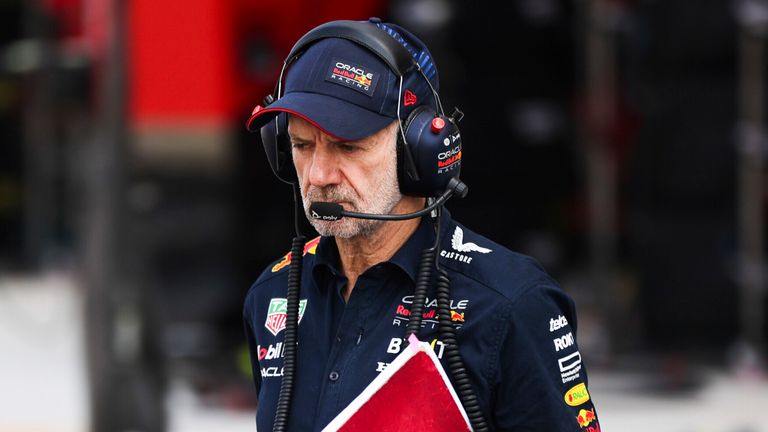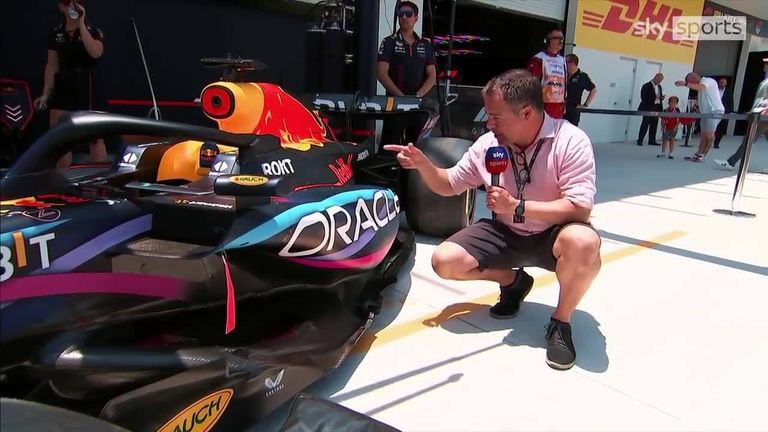F1: Adrian Newey talks Red Bull culture, copycat cars, power units and 2023 development race

Red Bull Chief Technology Officer Adrian Newey admitted he gave serious consideration to joining Team Ferrari twice in the 1990s
Red Bull Chief Technology Officer Adrian Newey admitted he gave serious consideration to joining Team Ferrari twice in the 1990s
Adrian Newey says Red Bull have a minimal email culture and is aware about the dangers of complacency.
Newey, who is regarded as one of F1’s greatest engineers, has played an instrumental role in Red Bull’s success during the last two years.
Twelve months after Red Bull was formed, Newey joined the Milton Keynes-based team and pioneered their four championship-winning cars between 2010 and 2013, as well as contributing to Max Verstappen’s success more recently.
“Theoretically I’m in charge of everybody but I never look at it that way. We try to run a very flat structure, where we encourage everyone to communicate and minimise the email culture, encourage people to talk – if it’s an aero designer, talk to the guy designing the mechanical solution for that aerodynamic shape,” he told Sky Italy.
“I think it’s about trying to have a very involving place to work. Then we have some very good senior engineers too.”
Newey is Red Bull’s chief technical officer, but there are several other key members of the team that have been pivotal in the last two years.

Christian Horner, Newey and Helmut Marko have played an instrumental role in Red Bull’s success in F1
Pierre Wache has been the team’s technical officer since 2018, Craig Skinner and Enrico Balbo head up the aerodynamics side, while Ben Waterhouse is Red Bull’s head of performance engineering.
Red Bull lead this year’s constructors’ championship by 135 points from Mercedes, while Max Verstappen and Sergio Perez head the drivers’ standings.
“We have to assume we are going to get pushed, so we have to keep developing. In F1, as soon as you become slightly complacent, you can be overtaken quite quickly,” said Newey.
“The regulations for next year are quite stable. Whatever we do in research for this year, will still be relevant for next year.”

Sky F1’s Damon Hill and Rachel Brookes discuss Mercedes’ chances of challenging the Red Bulls for race wins this season
Newey takes copying as ‘serious compliment’
The success of this season’s RB19 has led to other teams moving towards Red Bull’s design philosophy, with Mercedes choosing to divert from their no sidepod concept to much bigger sidepods, like Red Bull.
Perez joked it was “nice to see three Red Bull cars on the podium” after Fernando Alonso finished third in the season-opening Bahrain Grand Prix for Aston Martin.
“It’s a serious compliment when people copy. It’s part of F1 of course. We all look at each other. In truth, we have copied things from other people as well,” stated Newey.

Max Verstappen completed the Grand Chelem at the Spanish GP by topping every practice session, taking pole position and leading every lap on his way to victory
“Some of that copying is visual, some of it is occasionally from people moving around – we have seen that this year.
“It’s part of F1, it’s an intense competition. You can’t have pride. You have got to always evaluate what others are doing. You might end up directly copying it or it might give you ideas of ‘why have they done that’ and does that make you do something differently.”
Newey regularly looks at other cars on the grid ahead of a Grand Prix and explained what he learns from this: “More often than not it’s, ‘this looks interesting. Let’s have a look at what our car does in this area in detail and does what they have done spark any ideas of how we might develop our own car.’ Not necessarily by simply copying but why have they done that and does that bring any ideas.”

Verstappen had no trouble in securing his fifth win of the season at the Spanish Grand Prix, with the Mercedes pair of Lewis Hamilton and George Russell completing the podium places
Apprehensive about 2022 F1 regulations
Last year saw F1 introduce one of the biggest technical regulation changes in the sport’s history in a bid to increase the amount of wheel-to-wheel racing.
Whether the new rules have been a success has divided opinion but Newey admits he was relieved to see a variety of designs during pre-season testing and at the first race of 2022.
“I have to admit when the rules came out in 2020, they appeared very restrictive and I was quite concerned all the cars would look identical. There was a bit of relaxation because I think a lot of teams felt that way,” said the 64-year-old.

Despite winning his 40th race in Formula One at the Spanish Grand Prix, Verstappen insists he’s not focused on breaking records in the sport
“Once we got into the detail through 2021, it became apparent there was more flexibility with different designs than appeared at first sight.
“Particularly in the sidepod shapes there have been a huge variety. We don’t have the resources, when we are researching a car, to explore all avenues. So quite early on you go, ‘right this is the avenue we want to purse’ and off you go.
“Then you come out and see all these solutions and think, ‘oh crikey have we missed something’. Just because we started the year quite level with Ferrari, you don’t know which is going to be the best route eventually. Is it going to be Mercedes that perhaps they can develop further?
“Should we look more at what Ferrari did with their shape? In the end, we had a very quick look at the Mercedes to see what they were trying to achieve. We didn’t look at Ferrari and mainly concentrated on developing our own car and luckily we seem to have had a decent solution.”

Newey is considered one of F1’s greatest ever designers
Could 2026 risk more divergence in F1?
New power unit regulations in F1 from 2026 will see more reliance on the energy recovery system and the MGU-H being dropped.
There will be six power unit manufacturers in the championship in 2026 as Mercedes, Renault, Ferrari are joined by Audi, Ford and the formal return of Honda.
Red Bull will partner with Ford and Newey could still be around when the move takes place as Christian Horner told Sky Sports News the chief technical officer “will be around for many years to come”.

Sky F1’s Ted Kravitz explains the reasons as to why Red Bull have been so dominant in 2023.
In 2014, Red Bull were on the backfoot as Mercedes had a significant power unit advantage when the current turbo-hybrid regulations were introduced and Newey hopes the difference between the best and worst engine is not so big in three years time.
“When the hybrid regulations first came in, there were huge differences. Mercedes did a fantastic job with their power unit and others were varying levels behind,” he said.
“Now it’s closed up so I would say there’s maybe two or three per cent in the power difference, which is 0.2 to 0.3s difference perhaps, which when the grid is so tight, is still a big number. But it’s not like the one second when the regulations came out.
“The big risk now is another power unit shake-up in 2026, there could be a gap for a while. If there’s a big gap in power units, it takes time for the manufacturers to understand and close it, whereas chassis people can have a quicker reaction time.”
F1 returns in Canada from June 16-18 with all sessions live on Sky Sports F1, including race coverage from 5.30pm on Sunday June 18

Pingback: cumshot
Pingback: chat room
Pingback: lovecasino